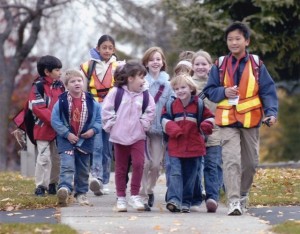What is a Walking School Bus?
The Walking School Bus is an organized system of walking with school children from home to school and back. Students in the same geographic area walk to school together under the supervision of an adult volunteer. Like a regular school bus, the Walking School Bus follows a planned and safe route with scheduled stops. Parents and other volunteers receive training and support to develop and implement the program and to supervise children walking to school.
In Waterloo Region, the Canadian Cancer Society offers a Walking School Bus program with support from the Ontario Trillium Foundation. Regional partners include the Waterloo Region Student Transportation Services, the Waterloo Region Block Parent program, and the Region of Waterloo Active and Safe Routes to School program.
Why participate in a Walking School Bus?
Walking to school is good for many reasons, including mental development, independent mobility, environmental, social and physical health benefits. A survey of families at four schools in Waterloo Region in 2015 found that parents of 4-10 year old students would allow their children to walk to school if…
- They were older;
- They did not have to walk alone;
- There were less traffic dangers; and
- There was a safer way to get there.
With families busier than ever, fewer students are afforded the opportunity to walk to school due to their age and lack of supervision. Walking School Buses are a convenient way for all children walk to school safely with the supervision of adults and/or older students.
My child already walks
Students who are currently walking to/from school can still participate and benefit from Walking School Buses. One of the most commonly reported benefits of Walking School buses is the social connections the adults and children build through their involvement (Kingham & Ussher, 2007). If you walk with your child(ren), you may want to consider helping out others in your neighbourhood by volunteering as a Walking School Bus leader.
We live too far from the school to walk
Most students who are not eligible for busing live within 1.6 km (1 mile) of their school. Using an average walking pace for children, a 1.6 km walk would take approximately 20 minutes. Try out the route with your child on a weekend and time yourselves. You might be surprised to see what your child is capable of! If it is still too far, consider joining up with a Walking School Bus at a stop closer to the school – at a distance your child is comfortable with.
If you are attending a school from outside of the school boundary and are not eligible for transportation, consider dropping your child off at a Walking School Bus stop rather than at the school.
My child is bussed to school
For many students who ride a bus to school, walking to their bus stop is just as important! A full Walking School Bus may not be feasible, so consider organizing a “walking buddies” program with others at your child’s bus stop. Older students can be paired up with younger ones to walk to the bus stop together or parents can take turns walking with students.
When do Walking School Buses operate?
Every school community is different, and it will be up to the Walking School Bus organizers to determine when and how frequently a Walking School Bus route will operate. Walking School Buses can be as formal or informal as needed. Consider the following potential options:
- Full school year, or seasonal
- Every week, or some weeks
- Every month, or some months
- Every day, or some days
- Mornings and/or after school
How do we start a Walking School Bus program at our school?
There are several important steps to consider in implementing a Walking School Bus program. Here are some of the highlights:
| Assess |
|
| Plan |
|
| Prepare |
|
For more information, please refer to the Canadian Cancer Society Walking School Bus program
Walking School Bus Videos
- Walking School Bus – Halton District School Board
- Trottibus Walking School Bus – We can walk everywhere!
- Trottibus – The Play Exchange
Benefits
In Québec, the following benefits of the Canadian Cancer Society’s Walking School Bus (Trottibus) program have been noted:
| Parent |
Sharing responsibility for the transportation of children Less stress – less rush in the morning Good time with your kids and their friends when you walk |
| Municipality |
Greener neighbourhoods Lower risk of collisions Less traffic |
| School |
Less traffic around the school Better concentration in class Young walkers become more punctual |
| Child |
Daily physical activity Opportunity to become a good pedestrian Enjoyment and sense of belonging to a group FUN!!! |
| Volunteer |
Daily physical activity Involvement in citizens in a inter-generational project Social interaction FUN!!! |
Beyond the health benefits, the Canadian Cancer Society’s Walking School Bus program:
- Makes the transportation of children to school safe
- Works against bullying
- Helps in the integration of immigrants in multicultural areas
- Provides a free and accessible means for all students to get to school
- Creates an environment conducive to physical activity
Tags: Active & Safe Routes to School · Trottibus · Walking School Bus
